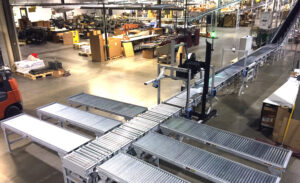Shipping Systems
End of Line Shipping Systems
Automating the shipping process is arguably one of the most overlooked places where rapid ROI is calling. There are so many opportunities to remove the touch labor from operators associated with processing packed boxes and packages. Hand scanning, manual measurement and weight, then hand applying a label is inefficient and consumes time for each package to be shipped.

A end of line shipping system typically includes:
- Existing or new conveyors to induct packages from pack stations
- Induction scanning to read customer license plate barcode or order ID
- Scale or checkweigher, with dimensional scanning (DWS system)
- Print and apply labeling system
- Verification scan
- A divert or reject device for exceptions
- Optional sortation between carriers or sort destinations, could be 2 or infinite sort lanes
ROI and System Payback
Typical ROI for an inline shipping system is based on labor and accuracy. The input labor is much less than manual processes, and most of the time trims pack station needs by 30% or more. A time study is a great idea to see exactly how much labor goes into each task, one by one. Contact us for help analyzing your needs.
- Labor: This area is the most obvious in terms of manual inputs for each step to ID, weigh, dimension, and label packages.
- Picking and Order Accuracy: Mismatches, shipping weights and dims, etc, can all be checked automatically compare to expected values. Business rules such as high value, high SKU counts, and random selection are ways to mitigate situations that are best done with human input.
- Seasonality: Many 3PL, distributors, and ecommerce fulfillment centers hire seasonal temps to keep up with spikes in demand. Automated lines are built to ramp up to peak demand without disruption of current flow while accommodating heavy shipping times and days.

